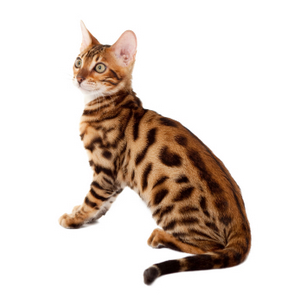|
Variations
|
|
- Black Silver Tabby
- Brown Spotted Tabby
- Brown Marbled Tabby
- Seal Mink Spotted Tabby
- Seal Mink Marbled Tabby
- Seal Sepia Spotted Tabby
- Seal Sepia Marbled Tabby
- Seal Silver Sepia Tabby
- Seal Spotted Lynx Point
- Seal Marbled Lynx Point
Interestingly, in Bengal house cats, the color brown encompasses several shades of brown – from near-black to gorgeous tones of bronze, copper, gray, gold, and rich fawn. You will also find silver and "snow" Bengals, which have a creamy-white color under their spots.
Color summary
Bengals come in the following colors:
- Brown and its variations (from the lightest shade to almost black)
- "Snow" colors: Seal Lynx Points, Seal Minks, and Seal Sepias
- Silver
There are, of course, some colors that are not accepted for competition. These colors are rare, too. What are these unrecognized colors?
- Blue
- Chocolate
- Cinnamon
- Red
Patterns and Markings
 The only accepted patterns for competition are the spotted and the marbled.
The only accepted patterns for competition are the spotted and the marbled.
Spotted pattern. It consists of distinctive spots and rosettes, giving Bengals a leopard-like appearance.
In this pattern, rosettes should be of two clearly defined shades. Spots can be large or small. They can also be random or arranged horizontally.
Marbled pattern. The marbled pattern showcases dramatic swirls and diagonal lines. It resembles the beautiful patterns of marble stone, hence the name.
Glittering. Some Bengal cats appear as if gold dust has been sprinkled all over their bodies. This opalescent shimmer gives these felines a unique look. This trait is not a Bengal marking per se, but it is worth mentioning.
Eye Color
TICA states that eye color in the Bengal house cat is independent of coat color, except in the lynx points. Lynx point Bengals should have blue eyes. The eye color in Seal Minks and Seal Sepias can be copper, green (aqua) or gold.
Coat length
The acceptable coat length for Bengals is short to medium. Occasionally, Bengal kittens with slightly longer hair are accepted for competition. It is rare to find long-haired Bengal cats, but you will find them.
More about Domestic Bengal cats
If you love Bengals, you will enjoy the following pages:
- Learn more about Bengal domestic cats. This article explores the history, evolution, and behavior of Bengals.
- Learn more about Bengal domestic cats. This article explores the history, evolution, and behavior of Bengals.
- Snow Bengals. Information about these unique felines.
- Pictures of Bengal cats. These images make wonderful cat lover gifts.
Looking for pet supplies? Check these out
Leave Bengal House Cat and return to Cat Breeds
Return to the Home Page of Cat Lovers Gifts Guide
 Mia was lovely, courageous, and one of the wisest cats I've ever met. This site is dedicated to her memory.
Mia was lovely, courageous, and one of the wisest cats I've ever met. This site is dedicated to her memory.
Max
 Max is our very own magical cat. He loves big mouse toys and is an avid bird watcher.
Max is our very own magical cat. He loves big mouse toys and is an avid bird watcher.







